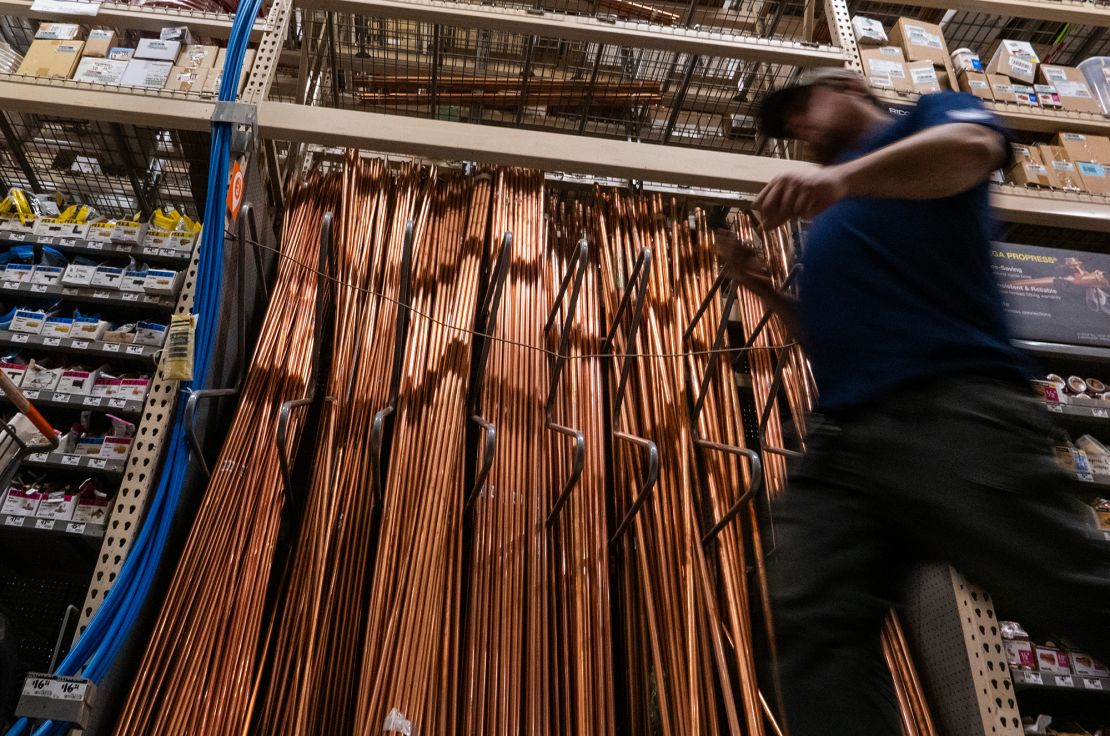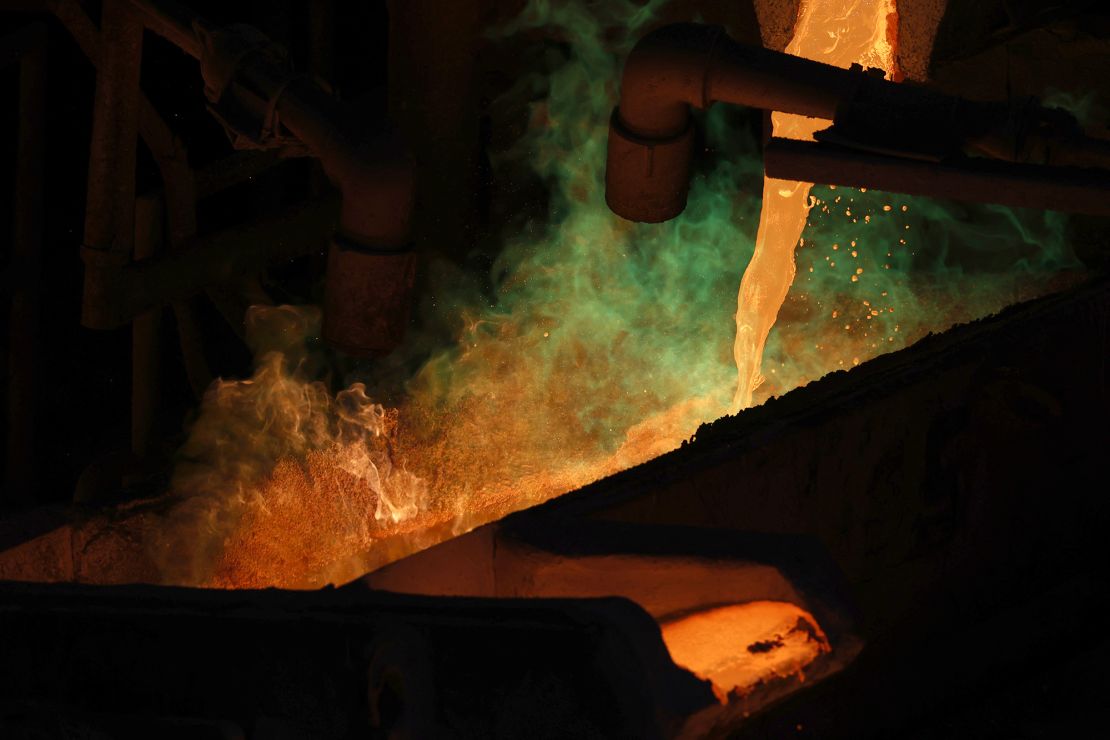New York
CNN
—
Copper is at the core of the American economy. It’s in the wires of our pervasive electronics, in the walls of homes and in the engines of cars. Experts say President Donald Trump’s plan for tariffs on the red metal could stymy the goal of boosting American manufacturing while potentially igniting inflation.
Trump’s July 8 announcement of a 50% tariff on copper imports beginning August 1 sent prices surging 13% in one day, up to a record high of $5.69 per pound.
It was the biggest single-day increase in copper prices on record going back to 1968, according to FactSet.
And those prices could just be a sign of things to come. A 50% tariff would be a “massive tax on consumers of copper,” Ole Hansen, head of commodity strategy at Saxo Bank, said in a note.
While Trump says his copper tariff is needed to spur domestic production due to national security concerns, there is no quick fix.
The US imports over 50% of the copper it needs, primarily from South America, Hansen said, “with no clear path to improving that for years to come.”
That’s because it takes almost 32 years, on average, from the discovery of mineable copper in the US to production, according to S&P Global Market Intelligence. And the end result of a big and fast copper tariff could simply be higher prices for many items, economists say.
“A tariff-induced price premium risks making copper—and by extension, US manufacturing and infrastructure—materially more expensive,” Hansen said.
Copper is highly conductive, making it a critical input for electrical and electronic products. Copper can be found in the chips in mobile phones, plumbing in houses and in the engines of cars.
“This is a vital metal for everyday use,” Rob Haworth, senior investment strategy director at US Bank’s asset management group, told CNN. “You probably don’t go a day where you haven’t used something that has copper in it.”
As Trump’s self-imposed August 1 tariff deadline approaches, businesses and investors don’t know what will happen in the wake of a massive tariff on a key component of the economy — let alone if the president will follow through with it at all, considering his history of backing off tariff threats.
Copper is one of the most widely used metals in the world. The typical American-made car has over 50 pounds of copper, according to the Copper Development Association, a trade group.
And the price of copper has been rising in recent years. The growing market for electric vehicles and the expansion of data centers thanks to the artificial intelligence boom have helped drive global demand for copper.
Copper prices this year have smashed through previous records amid Trump’s threat of tariffs. Copper futures in New York have soared almost 39% this year, outpacing the S&P 500’s 6% gain, bitcoin’s 24% gain and gold’s 26% gain.
Trump’s tariffs on metals, including steel and aluminum, are intended to bolster US supply chains. His administration also cited national security concerns for levying a tariff on copper.
But an import tax on copper would raise production costs for manufacturers in industries including construction, electronic goods and automobiles, according to Grace Zwemmer, an associate economist at Oxford Economics.
“All these tariffs raise costs and therefore injure downstream manufacturing,” Maurice Obstfeld, a professor of economics at UC Berkeley and member of former president Barack Obama’s council of economic advisers, told CNN.
“For the US, this seems like a fairly pointless act of self-harm,” Obstfeld added.
Businesses would face higher costs because there aren’t many viable substitutes for copper, according to Brandon Parsons, a practitioner of economics at Pepperdine Graziadio Business School. While aluminum can be a substitute, it is more flammable and does not have the same conductivity, making it less viable for using in items like semiconductor chips.
“There isn’t really a good way for businesses or consumers to avoid these higher costs,” he said. “It’s going to be felt widespread through the economy.”

Chile, Canada and Peru provided over 90% of US copper imports in 2024, according to the US Geological Survey.
The United States in 2024 mined an estimated 1.1 million tons of copper, according to the US Geological Survey, meeting just under half of its consumption. Arizona was home to more than 70% of domestic copper production in 2024.
Shifting economic incentives in the modern era and the opening of free trade have both contributed to a decline in US copper production, according to Pepperdine’s Parsons.
The United States in recent decades has produced less copper as the global economy liberalized, enabling the country to import relatively cheap copper from countries like Chile and allowing the US economy to expand to other industries.
Industrial buyers and Wall Street traders in recent months have shipped enormous amounts of copper to the United States to get ahead of potential tariffs. Morgan Stanley estimates 400,000 tons, or roughly six months’ worth of “extra” copper was front-loaded and delivered to the US in the early months of 2025.
The copper stockpiles could “temporarily buffer” the market when tariffs go into effect, according to Ewa Manthey, a commodity strategist at Dutch bank ING.
However, the buildup of copper won’t last forever, and it’ll be difficult for the US to produce enough copper domestically. At some point, the US will likely need to import more copper under the 50% tariff, which could risk a resurgence in inflation, Manthey said.
“Higher copper prices also risk higher inflation, raising costs for US manufacturers without a domestic alternative available,” Manthey said.
It remains to be seen whether companies will absorb the higher costs or pass the costs onto consumers in the form of higher prices, although economic theory suggests businesses would pass on higher costs to consumers when possible.
Wall Street and corporate America have been expecting tariffs on copper — just not 50%.
“Investors were caught off guard, as the market had been expecting a much lower tariff rate,” Adam Turnquist, chief technical strategist at LPL Financial, said in an email.
Smaller tariff rates such as 10% can be used strategically to encourage domestic manufacturing, economists say. But a rate as high as 50% could send a shock to markets, even leading to a drop in demand because prices are just too high.
That could lead to slower economic growth across industries, such as a lull in home building.
Plans to revive manufacturing and address national security concerns
Trump has espoused using tariffs as a means to boost US manufacturing. But tariffs are not a panacea that will revive the manufacturing industry, Pepperdine’s Parsons said.
“The rationale for this is to encourage production and investment in copper in the United States,” Parsons said. “The issue is it’s not like producing water, where you just open up the faucet. It could take years and years to open up a new copper mine, or even to expand production. So, while this does provide some incentive, it’s something that’s more long-run. You’re going to feel the short-run pain.”
Incentives like direct government subsidies or credits could promote domestic production of copper and fortify US supply chains, according to Parsons. While tariffs can help domestic companies sell more in the market, the higher prices can create unwanted ripple effects throughout the supply chain.

Trump in February signed an executive order opening a Section 232 investigation into copper imports. That section of the 1962 Trade Expansion Act gives the president the authority to impose import duties to protect industries deemed vital to US national security.
“The United States faces significant vulnerabilities in the copper supply chain, with increasing reliance on foreign sources for mined, smelted and refined copper,” the executive order said.
A Section 232 investigation comes with a 270-day deadline for an investigation, which means the Trump administration had until November to complete its review of copper, according to ING’s Manthey.
“There are many foreign suppliers of copper, including close allies like Canada, so a national security rationale seems contrived,” Berkeley’s Obstfeld said.
Trump said in a social media post on July 9 confirming his intent to impose tariffs on copper that the metal is the second most-used metal in the Defense Department.
But copper was not one of the 50 critical minerals designated by the US Geological Survey in 2022. The US Geological Survey is expected to publish an updated classification list for critical minerals this year.
However, copper is considered a “critical material” for energy, according to the Energy Department.
“The US has very limited current mining capacity,” Obstfeld said. “It will take a decade or more to onshore copper production substantially. That will still leave copper prices much higher in the US, and in the meantime, American consumers and businesses will suffer even more.”

